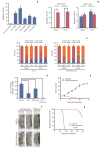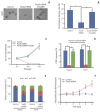Activation of Tyrosine Metabolism in CD13+ Cancer Stem Cells Drives Relapse in Hepatocellular Carcinoma
- PMID: 32019286
- PMCID: PMC7176959
- DOI: 10.4143/crt.2019.444
Activation of Tyrosine Metabolism in CD13+ Cancer Stem Cells Drives Relapse in Hepatocellular Carcinoma
Abstract
Purpose: Cancer stem cells (CSCs) are naturally resistant to chemotherapy, explaining why tumor relapse frequently occurs after initial regression upon administration of chemotherapeutic agents in most cases. A CSC population characterized by CD13 expression has been identified in hepatocellular carcinoma (HCC). In the current study, we aimed to clarify the molecular mechanism by which it escapes conventional therapies.
Materials and methods: Here, we used flow cytometry to examine the percentage of CD13+ CSCs in HepG2 and HuH7 cells after chemotherapy. Using in vitro isotope labeling technique, we compared metabolic pathways between CD13+ and CD13- subpopulations. Using co-immunoprecipitation and western blotting, we determined the target expressions in protein levels under different conditions. We also performed immunohistochemistry to detect the target proteins under different conditions. Animal models were constructed to verify the potential role of tyrosine metabolism in post-chemotherapeutic relapse in vivo.
Results: We observed that quiescent CD13+ CSCs are enriched after chemotherapy in HCCs, and serve as a reservoir for recurrence. Mechanistically, CD13+ CSCs were dependent on aerobic metabolism of tyrosine rather than glucose as energy source. Tyrosine metabolism also generated nuclear acetyl-CoA to acetylate and stabilize Foxd3, thereby allowing CD13+ CSCs cells to sustain quiescence and resistance to chemotherapeutic agents.
Conclusion: These findings encourage further exploration of eliminating CD13+ cells by targeting specific metabolic pathways to prevent recurrence in HCCs.
Keywords: CD13+ CSCs; Foxd3; Hepatocellular carcinoma; Quiescence; Tyrosine metabolism.
Conflict of interest statement
Conflict of interest relevant to this article was not reported.
Figures






Similar articles
-
CD13 is a therapeutic target in human liver cancer stem cells.J Clin Invest. 2010 Sep;120(9):3326-39. doi: 10.1172/JCI42550. Epub 2010 Aug 9. J Clin Invest. 2010. PMID: 20697159 Free PMC article.
-
A robust culture method for maintaining tumorigenic cancer stem cells in the hepatocellular carcinoma cell line Li-7.Cancer Sci. 2019 May;110(5):1644-1652. doi: 10.1111/cas.13978. Epub 2019 Mar 12. Cancer Sci. 2019. PMID: 30784169 Free PMC article.
-
The miR-200b-ZEB1 circuit regulates diverse stemness of human hepatocellular carcinoma.Mol Carcinog. 2017 Sep;56(9):2035-2047. doi: 10.1002/mc.22657. Epub 2017 Apr 18. Mol Carcinog. 2017. PMID: 28383782
-
Novel therapeutic target for cancer stem cells in hepatocellular carcinoma.J Hepatobiliary Pancreat Sci. 2012 Nov;19(6):600-5. doi: 10.1007/s00534-012-0543-5. J Hepatobiliary Pancreat Sci. 2012. PMID: 22892595 Review.
-
Cancer stem cell as a potential therapeutic target in hepatocellular carcinoma.Curr Cancer Drug Targets. 2012 Nov 1;12(9):1081-94. doi: 10.2174/156800912803987995. Curr Cancer Drug Targets. 2012. PMID: 22873219 Review.
Cited by
-
Integrating single-cell and bulk RNA sequencing reveals CK19 + cancer stem cells and their specific SPP1 + tumor-associated macrophage niche in HBV-related hepatocellular carcinoma.Hepatol Int. 2024 Feb;18(1):73-90. doi: 10.1007/s12072-023-10615-9. Epub 2023 Dec 30. Hepatol Int. 2024. PMID: 38159218
-
Validating Cell Surface Proteases as Drug Targets for Cancer Therapy: What Do We Know, and Where Do We Go?Cancers (Basel). 2022 Jan 26;14(3):624. doi: 10.3390/cancers14030624. Cancers (Basel). 2022. PMID: 35158891 Free PMC article. Review.
-
Uncovering the Mechanism of the Effects of Pien-Tze-Huang on Liver Cancer Using Network Pharmacology and Molecular Docking.Evid Based Complement Alternat Med. 2020 Sep 7;2020:4863015. doi: 10.1155/2020/4863015. eCollection 2020. Evid Based Complement Alternat Med. 2020. PMID: 32963562 Free PMC article.
-
The role of liver cancer stem cells in hepatocellular carcinoma metastasis.Cancer Biol Ther. 2024 Dec 31;25(1):2321768. doi: 10.1080/15384047.2024.2321768. Epub 2024 Feb 23. Cancer Biol Ther. 2024. PMID: 38393655 Free PMC article. Review.
-
Changes in the composition of the fecal metabolome and gut microbiota contribute to intervertebral disk degeneration in a rabbit model.J Orthop Surg Res. 2024 Jan 3;19(1):6. doi: 10.1186/s13018-023-04486-x. J Orthop Surg Res. 2024. PMID: 38169417 Free PMC article.
References
-
- Bray F, Ferlay J, Soerjomataram I, Siegel RL, Torre LA, Jemal A. Global cancer statistics 2018: GLOBOCAN estimates of incidence and mortality worldwide for 36 cancers in 185 countries. CA Cancer J Clin. 2018;68:394–424. - PubMed
-
- European Association for the Study of the Liver EASL clinical practice guidelines: management of alcohol-related liver disease. J Hepatol. 2018;69:154–81. - PubMed
MeSH terms
Substances
Grants and funding
LinkOut - more resources
Full Text Sources
Medical
Miscellaneous

